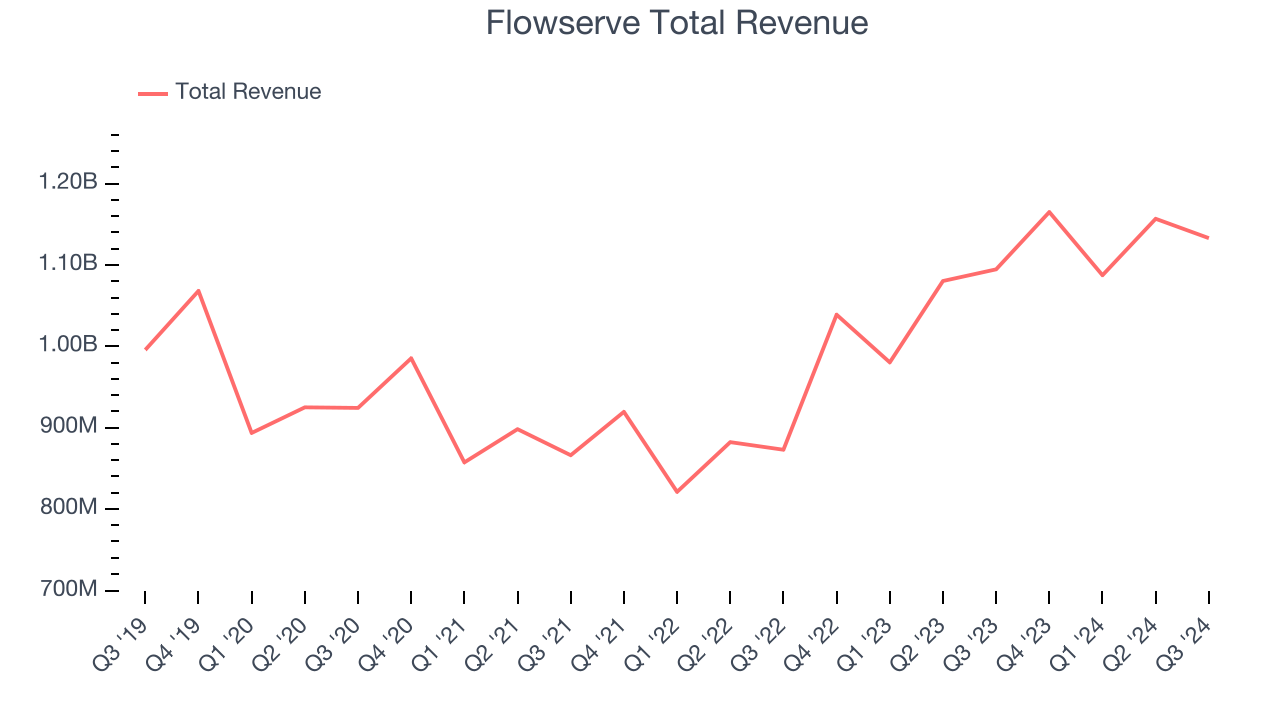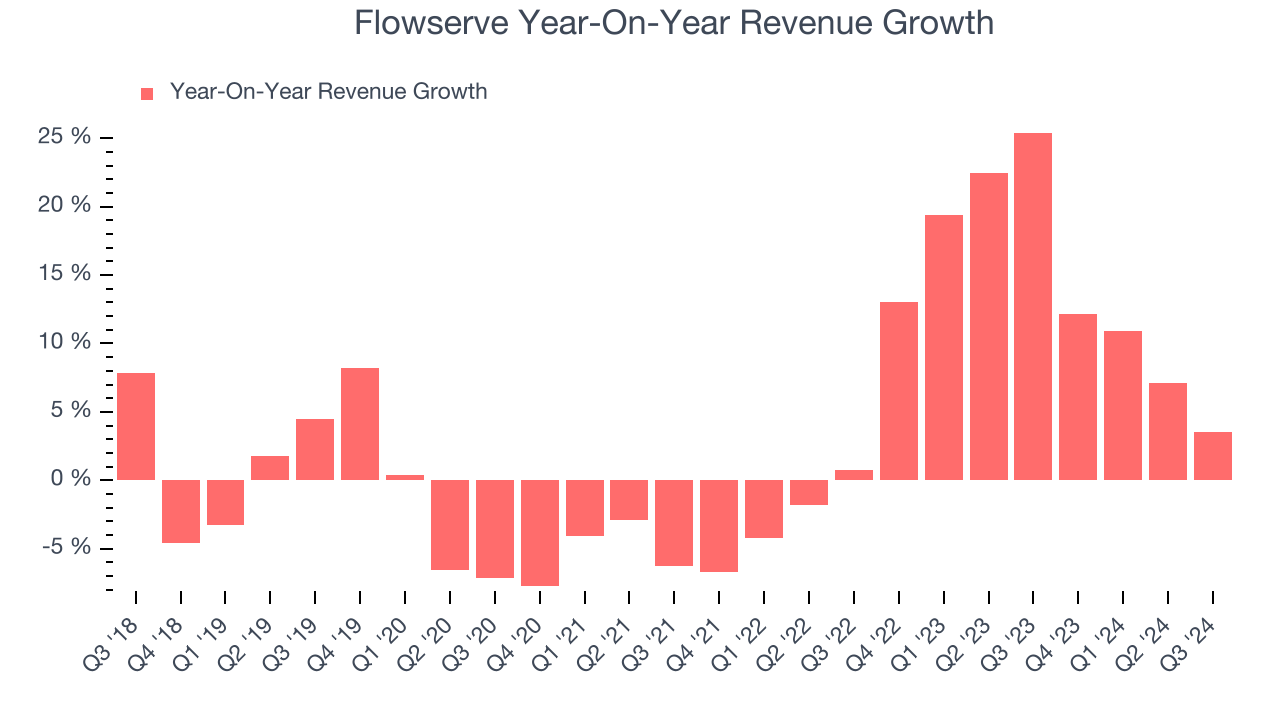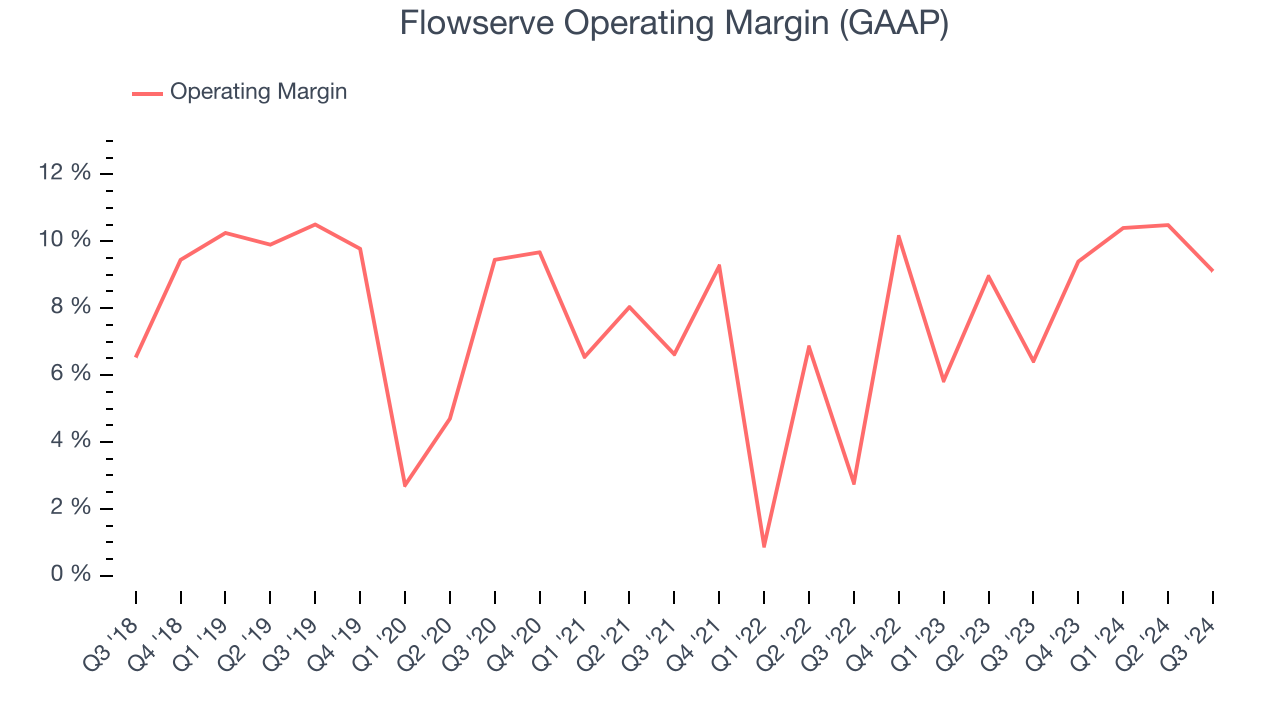
Flow control equipment manufacturer Flowserve (NYSE:FLS) met Wall Street’s revenue expectations in Q3 CY2024, with sales up 3.5% year on year to $1.13 billion. Its non-GAAP profit of $0.62 per share was 6.9% below analysts’ consensus estimates.
Is now the time to buy Flowserve? Find out by accessing our full research report, it’s free.
Flowserve (FLS) Q3 CY2024 Highlights:
- Revenue: $1.13 billion vs analyst estimates of $1.12 billion (in line)
- Adjusted EPS: $0.62 vs analyst expectations of $0.67 (6.9% miss)
- Adjusted EPS guidance for Q4 CY2024 is $2.68 at the midpoint, above analyst estimates of $0.78
- Gross Margin (GAAP): 31.5%, up from 29.7% in the same quarter last year
- Operating Margin: 9.1%, up from 6.4% in the same quarter last year
- Free Cash Flow Margin: 13.6%, up from 5.9% in the same quarter last year
- Backlog: $2.8 billion at quarter end
- Market Capitalization: $6.92 billion
“Our third quarter results reflect strong operational performance, including meaningful year-over-year improvements in margins, EPS and cash flow. The Flowserve Business System is beginning to deliver results as we advance our operational excellence and portfolio excellence initiatives. We generated $1.2 billion in bookings during the quarter, which included a healthy mix of project awards, strong aftermarket activity and record bookings from our 3D strategic initiatives,” said Scott Rowe, Flowserve’s President and Chief Executive Officer.
Company Overview
Manufacturing the largest pump ever built for nuclear power generation, Flowserve (NYSE:FLS) manufactures and sells flow control equipment for various industries.
Gas and Liquid Handling
Gas and liquid handling companies possess the technical know-how and specialized equipment to handle valuable (and sometimes dangerous) substances. Lately, water conservation and carbon capture–which requires hydrogen and other gasses as well as specialized infrastructure–have been trending up, creating new demand for products such as filters, pumps, and valves. On the other hand, gas and liquid handling companies are at the whim of economic cycles. Consumer spending and interest rates, for example, can greatly impact the industrial production that drives demand for these companies’ offerings.
Sales Growth
A company’s long-term performance can give signals about its business quality. Even a bad business can shine for one or two quarters, but a top-tier one grows for years. Regrettably, Flowserve’s sales grew at a sluggish 3.3% compounded annual growth rate over the last five years. This shows it failed to expand in any major way, a rough starting point for our analysis.

Long-term growth is the most important, but within industrials, a half-decade historical view may miss new industry trends or demand cycles. Flowserve’s annualized revenue growth of 14% over the last two years is above its five-year trend, suggesting its demand recently accelerated. 
This quarter, Flowserve grew its revenue by 3.5% year on year, and its $1.13 billion of revenue was in line with Wall Street’s estimates.
Looking ahead, sell-side analysts expect revenue to grow 4.2% over the next 12 months, a deceleration versus the last two years. This projection doesn't excite us and indicates the market thinks its products and services will see some demand headwinds. At least the company is tracking well in other measures of financial health.
Today’s young investors won’t have read the timeless lessons in Gorilla Game: Picking Winners In High Technology because it was written more than 20 years ago when Microsoft and Apple were first establishing their supremacy. But if we apply the same principles, then enterprise software stocks leveraging their own generative AI capabilities may well be the Gorillas of the future. So, in that spirit, we are excited to present our Special Free Report on a profitable, fast-growing enterprise software stock that is already riding the automation wave and looking to catch the generative AI next.
Operating Margin
Operating margin is one of the best measures of profitability because it tells us how much money a company takes home after procuring and manufacturing its products, marketing and selling them, and, most importantly, keeping them relevant through research and development.
Flowserve was profitable over the last five years but held back by its large cost base. Its average operating margin of 7.6% was weak for an industrials business.
On the bright side, Flowserve’s annual operating margin rose by 3 percentage points over the last five years.

In Q3, Flowserve generated an operating profit margin of 9.1%, up 2.7 percentage points year on year. The increase was encouraging, and since its operating margin rose more than its gross margin, we can infer it was recently more efficient with expenses such as marketing, R&D, and administrative overhead.
Earnings Per Share
We track the long-term change in earnings per share (EPS) for the same reason as long-term revenue growth. Compared to revenue, however, EPS highlights whether a company’s growth was profitable.
Flowserve’s EPS grew at an unimpressive 4.6% compounded annual growth rate over the last five years. On the bright side, this performance was better than its 3.3% annualized revenue growth and tells us the company became more profitable as it expanded.

Diving into the nuances of Flowserve’s earnings can give us a better understanding of its performance. As we mentioned earlier, Flowserve’s operating margin expanded by 3 percentage points over the last five years. This was the most relevant factor (aside from the revenue impact) behind its higher earnings; taxes and interest expenses can also affect EPS but don’t tell us as much about a company’s fundamentals.
Like with revenue, we analyze EPS over a shorter period to see if we are missing a change in the business.
For Flowserve, its two-year annual EPS growth of 68.8% was higher than its five-year trend. This acceleration made it one of the faster-growing industrials companies in recent history.In Q3, Flowserve reported EPS at $0.62, up from $0.50 in the same quarter last year. Despite growing year on year, this print missed analysts’ estimates. Over the next 12 months, Wall Street expects Flowserve’s full-year EPS of $2.62 to grow by 16.3%.
Key Takeaways from Flowserve’s Q3 Results
We were impressed by Flowserve’s optimistic EPS forecast for next quarter, which blew past analysts’ expectations. We were also glad its revenue outperformed Wall Street’s estimates. On the other hand, its EPS missed, making it a weaker quarter. The stock traded down 7.5% to $48.99 immediately after reporting.
Flowserve’s earnings report left more to be desired. Let’s look forward to see if this quarter has created an opportunity to buy the stock. What happened in the latest quarter matters, but not as much as longer-term business quality and valuation, when deciding whether to invest in this stock. We cover that in our actionable full research report which you can read here, it’s free.













